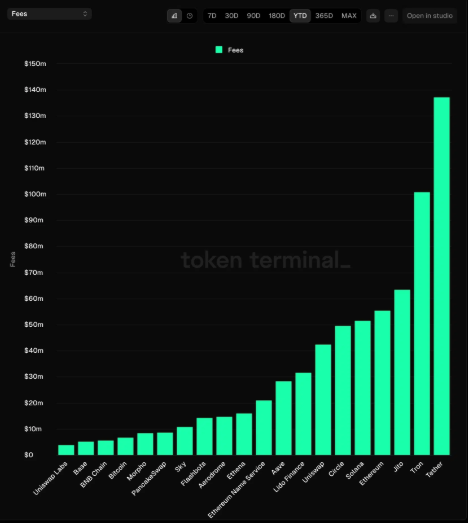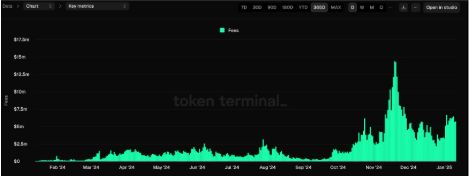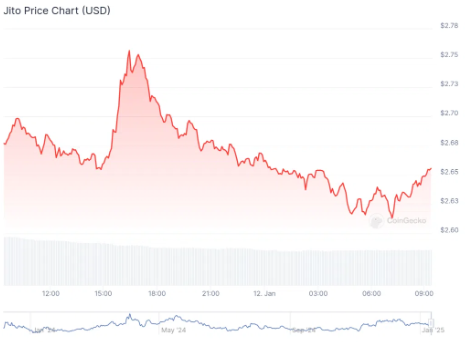Table of Contents
With a record-high total value locked (TVL) in its platform and fees, Jito, the largest liquid staking project on Solana, is performing well.
Data on its website indicates that Jito Jito jto -6%
Jito has a TVL of $2.7 billion, or 14.6 million SOL. With this volume, it ranks third in terms of liquid staking protocol after Lido and Binance Staked ETH, and it is the fourteenth largest player in the decentralized finance sector.
This year, Jito is outperforming Uniswap, Ethereum, and Solana.
In addition to flipping Solana Solana sol -1.15%, Ethereum eth -1.7%, and Uniswap in fees made this year, Jito has around 150,000 users.
TokenTerminal reports that Jito has made $63 million in fees so far this year, while Ethereum has made $55.1 million. The earnings for Solana and Uniswap Uni are $51 million and $42.1 million, respectively.
After Tether and Tron, which have earned $137 million and $100 million, respectively, Jito is now the third cryptocurrency project in terms of fees this year. Additionally, it has emerged as the DeFi industry’s most lucrative participant. Additionally, its fees are greater than those of Lido Finance, the largest liquid staking platform with $31 million in revenue so far this year.

Additionally, it has earned $559 million in fees over the past 180 days and $729 million over the past 12 months.
After dropping to $2.25 million in December from an all-time high of $14.1 million in November, Jito’s daily fees have now recovered.

Jito provides two primary options.
Jito provides liquid staking and restaking to its customers. Users that participate in liquid staking move their staked tokens to the network and exchange them for JitoSOL, also known as an LST.
Because the LST is a liquid token, holders can trade and use it in DeFi protocols, in contrast to the conventional staking method. Jito claims that the average Solana staking yield is 7.4%, while the current yield of staked LSTs is 9.81%.
Restaking, a service that tokenizes staked assets as Vault Receipt Tokens, or VRT, has also been created by Jito. Over time, restaking enables owners of staked assets to increase their returns. The total locked value of Jito’s restaked tokens is $42.6 million.
However, since its 2023 airdrop, Jito’s token has not done well. On January 12, it was selling at $2.64, 40% lower than its peak in December and 50% lower than its peak of $5.3.

Since 11.31 million JTO tokens will be released monthly until December 2026, the network’s regular dilution is the cause of this performance. With a supply cap of 281 million, there are now 281 million JTO tokens in use.
FAQ
Jito is the largest liquid staking project on the Solana blockchain. It is significant because it has achieved a record-high total value locked (TVL) of $2.7 billion and generated $63 million in fees this year, outperforming major players like Ethereum, Solana, and Uniswap in terms of revenue.
Jito provides two primary services:
- Liquid Staking: Users stake their tokens and receive JitoSOL (an LST) in return, which can be traded or used in DeFi protocols. The staking yield for JitoSOL is currently 9.81%.
Restaking: Jito tokenizes staked assets as Vault Receipt Tokens (VRT), enabling users to earn additional returns.
Jito ranks as the third-largest liquid staking protocol globally, trailing only Lido and Binance Staked ETH. In terms of fees generated, Jito has outperformed Lido, Ethereum, Solana, and Uniswap this year, making it one of the most profitable participants in the DeFi sector.
The decline in JTO’s value is attributed to regular token dilution. With 11.31 million JTO tokens released monthly until December 2026, the token’s supply continues to grow, putting downward pressure on its price.
JitoSOL: A liquid staking token users receive when staking SOL with Jito. It offers liquidity and higher staking yields (currently 9.81%).
Vault Receipt Tokens (VRT): A tokenized representation of staked assets used for restaking, allowing users to maximize their returns over time.




 Bitcoin
Bitcoin  Ethereum
Ethereum  Tether
Tether  Solana
Solana  USDC
USDC  Lido Staked Ether
Lido Staked Ether  XRP
XRP  Toncoin
Toncoin  Dogecoin
Dogecoin  Cardano
Cardano  TRON
TRON  Shiba Inu
Shiba Inu  Avalanche
Avalanche  Wrapped Bitcoin
Wrapped Bitcoin  Polkadot
Polkadot  Chainlink
Chainlink  Bitcoin Cash
Bitcoin Cash  Uniswap
Uniswap  NEAR Protocol
NEAR Protocol  LEO Token
LEO Token  Dai
Dai  Litecoin
Litecoin  Polygon
Polygon  Wrapped eETH
Wrapped eETH  Internet Computer
Internet Computer  Pepe
Pepe  Ethena USDe
Ethena USDe  Ethereum Classic
Ethereum Classic  Artificial Superintelligence Alliance
Artificial Superintelligence Alliance  Aptos
Aptos  Stellar
Stellar  Monero
Monero  Maker
Maker  Hedera
Hedera  Stacks
Stacks  Cronos
Cronos  Render
Render  Filecoin
Filecoin  Cosmos Hub
Cosmos Hub  OKB
OKB  Mantle
Mantle  Arbitrum
Arbitrum  Renzo Restaked ETH
Renzo Restaked ETH  Immutable
Immutable  Sui
Sui  Injective
Injective  Optimism
Optimism